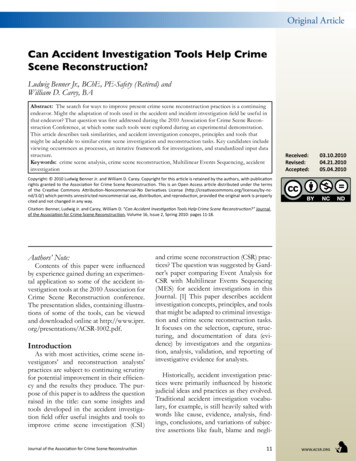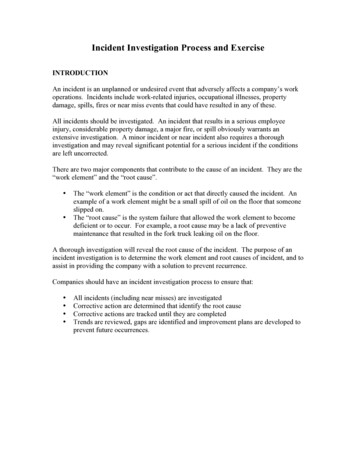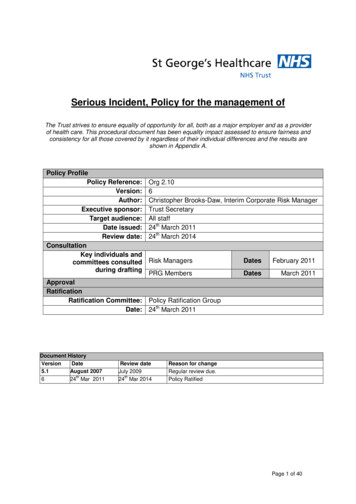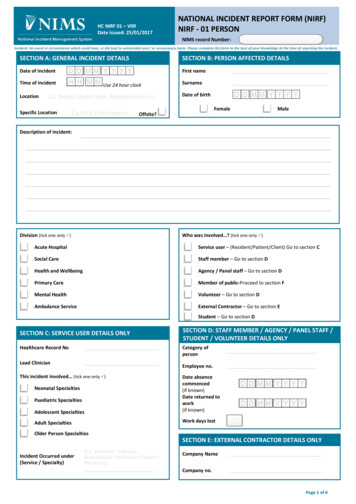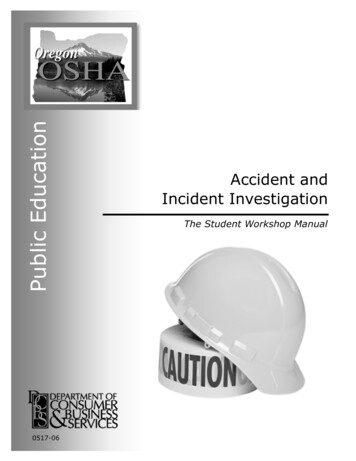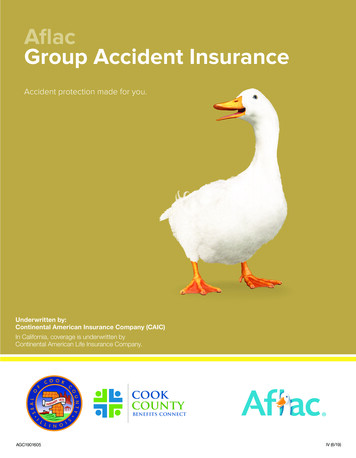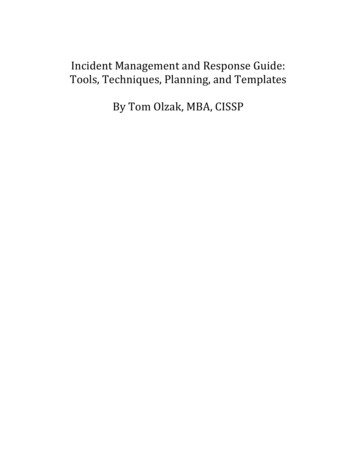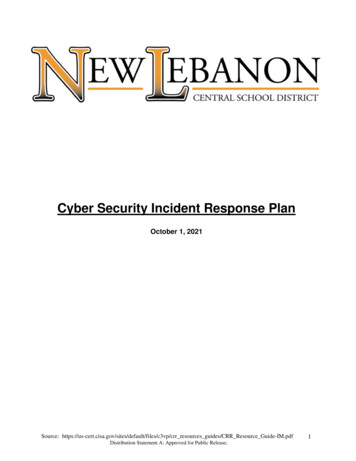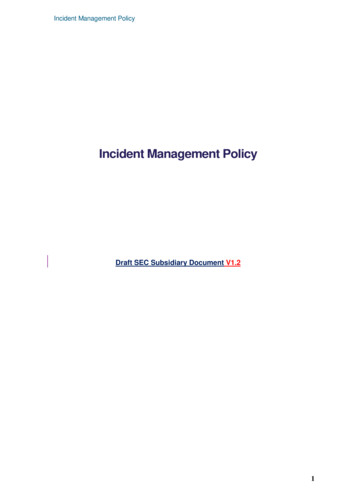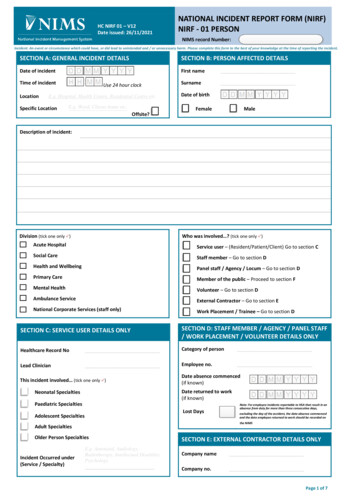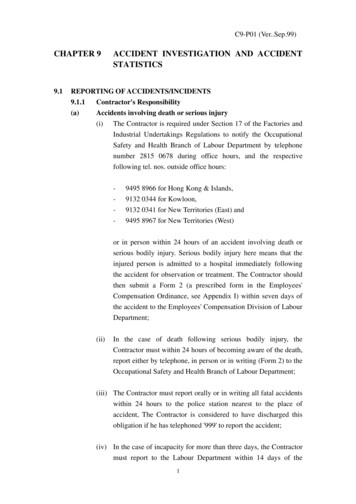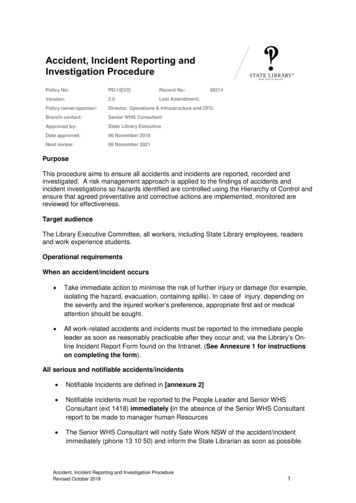
Transcription
Accident, Incident Reporting andInvestigation ProcedurePolicy No:PD/15[V2]Record No:58214Version:2.0Last Amendment:Policy owner/sponsor:Director. Operations & Infrastructure and CFOBranch contact:Senior WHS ConsultantApproved by:State Library ExecutiveDate approved:06 November 2018Next review:06 November 2021PurposeThis procedure aims to ensure all accidents and incidents are reported, recorded andinvestigated. A risk management approach is applied to the findings of accidents andincident investigations so hazards identified are controlled using the Hierarchy of Control andensure that agreed preventative and corrective actions are implemented, monitored arereviewed for effectiveness.Target audienceThe Library Executive Committee, all workers, including State Library employees, readersand work experience students.Operational requirementsWhen an accident/incident occurs Take immediate action to minimise the risk of further injury or damage (for example,isolating the hazard, evacuation, containing spills). In case of injury, depending onthe severity and the injured worker’s preference, appropriate first aid or medicalattention should be sought. All work-related accidents and incidents must be reported to the immediate peopleleader as soon as reasonably practicable after they occur and, via the Library’s Online Incident Report Form found on the Intranet. (See Annexure 1 for instructionson completing the form).All serious and notifiable accidents/incidents Notifiable Incidents are defined in [annexure 2] Notifiable incidents must be reported to the People Leader and Senior WHSConsultant (ext 1418) immediately (in the absence of the Senior WHS Consultantreport to be made to manager human Resources The Senior WHS Consultant will notify Safe Work NSW of the accident/incidentimmediately (phone 13 10 50) and inform the State Librarian as soon as possible.Accident, Incident Reporting and Investigation ProcedureRevised October 20181
The person responsible for managing or controlling the area where a notifiableaccident/incident has occurred must ensure, so far as is reasonably practicable, thatthe site where the incident occurred is not disturbed – including any plant, substance,structure or thing associated with the notifiable incident until an inspector from SafeWork NSW arrives at the site or any earlier time the inspector directs.Workers may take such steps as are necessary: to assist an injured person, to allow emergency services to remove a deceased person, or that is essential to make the site safe or to minimise the risk of a furthernotifiable incident to comply with a police investigation or with an inspector of the regulator where permission has been given.Incident Outside of normal working hours When an incident occurs outside of normal working hours, the SecurityCoordinator rostered on the day and/or the Officer in Charge in the reading roomswill determine if notification to Safe Work NSW is required. All completed documentation must be passed onto the Senior WHS Consultant onthe next available working day.Incident InvestigationThe immediate People Leader will investigate the accident/incident in consultation with theHealth and Safety Committee member representing the area and the worker involved wherepossible. The Senior WHS Consultant will also be available to give necessary advice at anytime during the investigation.The focus of the investigation is to obtain an accurate picture of what occurred by: Examining the accident scene and recording any physical evidence related to theevent. Interview people involved or any witnesses Review background information such as procedures for the work being carried out,maintenance reports, training reports or previous similar events.For serious and notifiable incidents, the findings of the investigation, including relevantcorrective actions must be recorded in the form of a report addressed to the ExecutiveCommittee member representing the area.For less serious incidents investigation details, can be noted on the Incident Report formalong with any correction actions.Accident, Incident Reporting and Investigation ProcedureRevised October 20182
Corrective and preventative actionsAll stake holders involved in the investigation must identify corrective or preventative actionsrequired to prevent the accident or incident reoccurring.Risks are rated in accordance with the Library’s WHS Risk Management Matrix. Controlmeasures selected in descending order from the Hierarchy of Controls. Depending on theoutcome of the investigation, both short and long-term control measures may be required.See Risk Management Guidelines for further clarification.Monitor and Review actions for effectivenessThe immediate people leader will Track and monitor the implementation of corrective/preventive actions Evaluate controls for effectiveness in consultation with workers in the affected areaand any other stakeholders Review any new hazards as they are identified Include new control measures into the workplace inspection process Communicate outcome of incident investigation to the Senior WHS Consultant soresults can be added to the appropriate TRIM file. Close out any outstanding corrective or preventative actions and report.ResponsibilitiesThe Executive Committee will provide leadership and direction to ensure accidents and incidents are managedefficiently and all reporting requirements are met ensure the Library’s accident and incident reporting and investigation process isincluded in all inductions ensure managers and people leaders are trained in the requirements for reportingand investigating accidents and incidents ensure resources required to implement agreed preventative and corrective actionsare available and dealt with as a priority.Managers and People Leaders will ensure that all staff under their control are aware of the content of this procedure undertake training provided on the reporting and investigation of accidents andinjuries complete managers section of the Incident Report Form (even when no injury isapparent) report serious or notifiable incidents to the Senior WHS Consultant who will reportincident to Safe Work NSW. be part of incident investigation team as required when part of an investigation team, apply a risk management approach so thathazards are identified and dealt with in line with the Hierarchy of Controls ensure agreed preventative measures and corrective measures are implemented,monitored and reviewedAccident, Incident Reporting and Investigation ProcedureRevised October 20183
maintain privacy and confidentiality of personal and health information in accordancewith NSW privacy legislationWorkers will be aware of requirements for reporting of accidents and incidents report all incidents and accidents as soon as reasonable practicable on the IncidentReport Form and send to immediate people leader maintain privacy and confidentiality of health information pertaining to an injuredworker in accordance with NSW privacy legislationSenior WHS Consultant will ensure that all serious and notifiable incidents are reported to Safe Work NSW, theState Librarian, Director Operations and Infrastructure & CFO and Manager HumanResources monitor and update Incident Report Form assist in incident investigations including identifying preventative and correctiveactions including implementation and review keep induction information relating to incident investigation up to date and explainthe process at inductions ensure that WHS training for managers and people leaders including the incidentand accident reporting and investigation process is reviewed and maintained reports all accidents to the Health and Safety Committee, Executive Committee,Audit and Risk Committee and Library Council ensure that all accidents and incidents are recorded on a Library Incident Registerand retained on a TRIM file maintain privacy and confidentiality of personal and health information inaccordance with NSW privacy legislationWHS Committee/ Health and Safety Representative Receive and review data on accidents and incidents reported Participate in the incident investigation process as required Monitor and review the corrective action for effectivenessRelated Key Legislation and Policy Work Health and Safety Act 2011 Work Health and Safety Regulation 2011 Government Information (Public Access) Act 2001 Australia/ New Zealand Standard AS/NZS 4801/2001 State Library Work Health and Safety Policy State Library Risk Management ProcedureKey definitionsAccident means an unplanned occurrence or incident that causes or contributes to personalinjury or property damage.Incident means any unplanned event resulting in, or having a potential for injury, ill health,damage or other loss (as defined by Australian/New Zealand Standard AS/NZ 4801:2001).Accident, Incident Reporting and Investigation ProcedureRevised October 20184
Worker means a person who carries out work in a capacity for the PCBU. A worker includesan employee, apprentice, trainee, contractor, sub-contractor, an employee of a labour hirecompany, work experience student, outworker or volunteer.Hierarchy of Control is a range of control measures in priority order, that can be used toeliminate or minimise exposure to hazards.Serious or Notifiable IncidentOnly the most serious health and safety incidents are notifiable, and only if they are workrelated. They trigger requirements to preserve the incident site pending further direction fromthe regulator (Safe Work NSW).AttachmentsAnnexure 1 – Instructions on completion of Incident Report FormAnnexure 2 - Safe Work Australia – Incident Notification Fact SheetDocument history and version controlVersionDate approvedApproved byBrief description1.006/11/2018State Library ExecutiveNew procedureAccident, Incident Reporting and Investigation ProcedureRevised October 20185
Accident, Incident Reporting and Investigation ProcedureRevised October 20186
Annexure 1 Instruction oncompletion of WHS Incident Report FormStep 1 LogonWhen you clink on the Incident Report Form Link (always ensure you are in Chrome or Firefox, not Internet Explorer) you will be brought to the screenbelow. Logon with your normal system Login and Password.1
Annexure 1 Instruction oncompletion of WHS Incident Report FormStep 2When you log into the Incident Report Form this is the screen you will see.2
Annexure 1 Instruction oncompletion of WHS Incident Report Form You will not see the “All Reported Incidents” box“Incidents Reported by me” is anything that you have reported personally“Incidents Reported by my Staff Member” is anything that you record as a people leaderStep 3If you are reporting an incident, you will fill out Parts A and B3
Annexure 1 Instruction oncompletion of WHS Incident Report Form4
Annexure 1 Instruction oncompletion of WHS Incident Report Form5
Annexure 1 Instruction oncompletion of WHS Incident Report FormStep 4Part D is completed by Supervisor/Team Leader6
Annexure 1 Instruction oncompletion of WHS Incident Report FormStep 5Part E This is competed by Senior WHS Consultant7
Annexure 1 Instruction oncompletion of WHS Incident Report FormStep 6This is a report in PDF generated by the system run by the Senior WHS Consultant8
Annexure 1 Instruction oncompletion of WHS Incident Report Form9
Annexure 1 Instruction oncompletion of WHS Incident Report FormThis document will then be printed and the Senior WHS Consultant with the ask all parties to sign the form.This with then be kept as a permanent record of the Incident.10
Annexure 1 Instruction oncompletion of WHS Incident Report FormFinal OutcomeThe incident is now reported on the Senior WHS Consultant’s home page, this is now the incident register for the Library.If you reported the incident it will show as “Incidents reported by me”11
Annexure 1 Instruction oncompletion of WHS Incident Report FormIf you are a supervisor/team leader it will be reported as “Incidents reported by my staff members”.12
Annexure 2INCIDENTNOTIFICATIONHeadingINFORMATION SHEETOverviewThis information sheet provides general guidanceon mandatory reporting requirements for‘notifiable incidents’ under Work Health andSafety (WHS) legislation.www.safeworkaustralia.gov.auISBN 978-1-76028-465-7 [PDF]978-1-76028-466-4 [DOCX]
Businesses and undertakings must notify theirwork health and safety regulator of certain‘notifiable incidents’ at work. This informationsheet will help you decide when you need tonotify the regulator of a work-related death,injury, illness or dangerous incident.Work health and safety regulators arecommitted to preventing work-relateddeaths and injuries. Notifying the regulator of‘notifiable incidents’ can help identify causesof incidents and prevent similar incidents atyour workplace and other workplaces.The WHS law requires: a ‘notifiable incident’ to be reported tothe regulator immediately after becomingaware it has happened if the regulator asks—written notificationwithin 48 hours of the request, and the incident site to be preserved untilan inspector arrives or directs otherwise(subject to some exceptions).Failing to report a ‘notifiable incident’ is anoffence and penalties apply.What is a ‘notifiable incident’A ‘notifiable incident’ is: the death of a person a ‘serious injury or illness’, or a ‘dangerous incident’arising out of the conduct of a business orundertaking at a workplace.‘Notifiable incidents’ may relate to anyperson—whether an employee, contractor ormember of the public.Serious injury or illnessOnly the most serious health or safetyincidents are notifiable, and only if they arework-related. They trigger requirements topreserve the incident site pending furtherdirection from the regulator.Serious injury or illness must be notified if theperson requires any of the types of treatmentin the following table:Types of treatmentExampleImmediate treatmentas an in-patient in ahospitalAdmission into a hospital as an in-patient for any duration, evenif the stay is not overnight or longer.It does not include:Out-patient treatment provided by the emergency section ofa hospital (i.e. not requiring admission as an in-patient)Admission for corrective surgery which does not immediatelyfollow the injury (e.g. to fix a fractured nose).Immediate treatment forthe amputation of anypart of the bodyAmputation of a limb such as arm or leg, body part such as hand,foot or the tip of a finger, toe, nose or ear.Immediate treatment fora serious head injuryFractured skull, loss of consciousness, blood clot or bleedingin the brain, damage to the skull to the extent that it is likely toaffect organ/face function.Head injuries resulting in temporary or permanent amnesia.It does not include:A bump to the head resulting in a minor contusion or headache.www.safeworkaustralia.gov.auNOVEMBER 2015 Page: 2
Types of treatmentExampleImmediate treatment fora serious eye injuryInjury that results in or is likely to result in the loss of the eye ortotal or partial loss of vision.Injury that involves an object penetrating the eye (for examplemetal fragment, wood chip).Exposure of the eye to a substance which poses a risk of seriouseye damage.It does not include:Eye exposure to a substance that merely causes irritation.Immediate treatment fora serious burnA burn requiring intensive care or critical care which could requirecompression garment or a skin graft.It does not include:A burn that merely requires washing the wound and applyinga dressing.Immediate treatmentfor the separation ofskin from an underlyingtissue (such as degloving or scalping)Separation of skin from an underlying tissue such that tendon, boneor muscles are exposed (de-gloving or scalping).Immediate treatment fora spinal injuryInjury to the cervical, thoracic, lumbar or sacral vertebrae includingthe discs and spinal cord.It does not include:Minor lacerations.It does not include:Acute back strain.Immediate treatmentfor the loss of a bodilyfunctionLoss of consciousness, loss of movement of a limb or loss of thesense of smell, taste, sight or hearing, or loss of function of aninternal organ.It does not include:Mere faintingA sprain or strain.Immediate treatment forserious lacerationsDeep or extensive cuts that cause muscle, tendon, nerve or bloodvessel damage or permanent impairment.Deep puncture wounds.Tears of wounds to the flesh or tissues—this may include stitchingto prevent loss of blood and/or other treatment to prevent loss ofbodily function and/or infection.www.safeworkaustralia.gov.auNOVEMBER 2015 Page: 3
Types of treatmentExampleMedical treatment within ‘Medical treatment’ is treatment provided by a doctor.48 hours of exposure toExposure to a substance includes exposure to chemicals, airbornea substancecontaminants and exposure to human and/or animal blood andbody substances.Notification is also required for the followingserious illnesses: Any infection where the work is asignificant contributing factor. Thisincludes any infection related to carryingout work:(i) with micro-organisms(ii) that involves providing treatment orcare to a person(iii) that involves contact with humanblood or body substances(iv) that involves handling or contact withanimals, animal hides, skins, wool or hair,animal carcasses or animal waste products. The following occupational zoonosescontracted in the course of work involvinghandling or contact with animals, animalhides, skins, wool or hair, animal carcassesor animal waste products:Even if immediate treatment is not readilyavailable, for example because the incidentsite is rural or remote or because the relevantspecialist treatment is not available, thenotification must still be made.Still unsure?If you are still unsure about whether aparticular incident should be notified thencontact your regulator for advice or furtherguidance. Contact details are included below.Dangerous incidents including‘near misses’Some types of work-related dangerousincidents must be notified even if no-one isinjured. The regulator must be notified ofany incident in relation to a workplace thatexposes any person to a serious risk resultingfrom an immediate or imminent exposure to: an uncontrolled escape, spillage or leakageof a substance(i) Q fever(ii) Anthrax an uncontrolled implosion, explosion or fire(iii) Leptospirosis an uncontrolled escape of gas or steam(iv) Brucellosis(v) Hendra Virus an uncontrolled escape of a pressurisedsubstance(vi) Avian Influenza electric shock:(vii) Psittacosis. examples of electrical shock that are notnotifiableTreatment‘Immediate treatment’ means the kind ofurgent treatment that would be required for aserious injury or illness. It includes treatmentby a registered medical practitioner, aparamedic or registered nurse.‘Medical treatment’ refers to treatment by aregistered medical practitioner (a doctor).ŘŘ shock due to static electricityŘŘ ‘extra low voltage’ shock (i.e. arisingfrom electrical equipment less than orequal to 50V AC and less than or equalto 120V DC)ŘŘ defibrillators are used deliberatelyto shock a person for first aid ormedical reasonswww.safeworkaustralia.gov.auNOVEMBER 2015 Page: 4
examples of electrical shocks that arenotifiableŘŘ minor shock resulting from directcontact with exposed live electricalparts (other than ‘extra low voltage’)including shock from capacitivedischarge the fall or release from a height of anyplant, substance or thing the collapse, overturning, failure ormalfunction of, or damage to, anyplant that is required to be design oritem registered under the Work Healthand Safety Regulations, for example acollapsing crane the collapse or partial collapse of astructure the collapse or failure of an excavation orof any shoring supporting an excavation the inrush of water, mud or gas in workings,in an underground excavation or tunnel, or the interruption of the main system ofventilation in an underground excavation ortunnel.A dangerous incident includes both immediateserious risks to health or safety, and also a riskfrom an immediate exposure to a substancewhich is likely to create a serious risk to healthor safety in the future, for example asbestos orhazardous chemicals.Only work-related incidentsare notifiableTo be notifiable, an incident must arise out ofthe conduct of the business or undertaking.An incident is not notifiable just because ithappens at or near a workplace.Incidents may happen for reasons which donot have anything to do with work or theconduct of the business or undertaking,for example: a worker or another person suffers a heartattack while at work which is unrelatedto work or the conduct of the businessor undertaking an amateur athlete is injured while playing forthe local soccer team and requires immediatemedical treatment (this is not work) a person driving to work is injured in a caraccident (where driving is not partof their work) a person with epilepsy has a seizure atwork.These kinds of incidents are not notifiable.Work-related incidents that occuroutside a workplace may be notifiableWork-related incidents may affect peopleoutside the workplace. These may still benotifiable if they involve a death, serious illnessor injury or a dangerous incident.For example: an object like a hand tool falls off a multistorey building under construction hitting aperson below scaffold collapse that causes a risk ofserious injury to persons adjacent to aconstruction site an awning over a shop-front collapses,hitting a person underneath it.Appendix A provides more information aboutincidents at public places or sporting events.Who is responsiblefor notifying?Any person conducting a business orundertaking (PCBU) from which the ‘notifiableincident’ arises must ensure the regulator isnotified immediately after becoming aware ithas happened.Procedures should be put into place toensure work health and safety incidents arepromptly notified to the people responsible forresponding to them, for example a managerand then notified to the regulator, if required.Incidents involving multiplebusinesses or undertakingsIf a ‘notifiable incident’ arises out of more thanone business or undertaking then each mustensure that the incident has been notified tothe regulator.www.safeworkaustralia.gov.auNOVEMBER 2015 Page: 5
There is no need for all duty holders to notify—only one needs to. However, all duty holdersretain their responsibility to notify, regardlessof any agreement between them.In these circumstances the duty holdersmust, so far as is reasonably practicable,consult, cooperate and coordinate to putappropriate reporting and notificationarrangements in place.For example contractors at a constructionworkplace may agree that the principalcontractor for the workplace will notify all‘notifiable incidents’ that occur atthe workplace.Incidents involving a ‘Statebased contractor working for aCommonwealth entity’Workplaces shared by a Commonwealthentity and one or more state-basedcontractors may be covered by bothCommonwealth and state or territory workhealth and safety (WHS) laws.For example an asbestos removal companyis engaged by the Department of Defence(Defence) to carry out asbestos removalwork at Randwick Army Barracks in Sydneyand a dangerous incident occurs (as definedabove). Because the incident has occurredat a place where work is carried out forDefence (on behalf of the Commonwealth) thecompany must ensure that both Comcare andWorkCover NSW are notified of the incident.Defence and the company may co-operate sothat only one notification is made to Comcareon behalf of both.When and how to notifyYou must notify the regulator immediatelyafter becoming aware of a ‘notifiable incident’.The notice must be given by the fastestpossible means—which could be by telephoneor in writing, for example by email or online (ifavailable). See page 8 for contact details.Regulators have adopted a common-senseapproach to assessing whether an incidenthas been notified immediately. This meansincidents must be notified as soon as theparticular circumstances permit.In general a PCBU ‘becomes aware’ ofa notifiable incident once any of theirsupervisors or managers becomes awareof the incident. For example when a workersuffers a serious injury and reports it to theirimmediate supervisor, it is at this pointthat the PCBU is considered to be aware ofthe incident.It is therefore essential to develop internalcommunication systems to ensure health orsafety incidents are promptly brought to therelevant persons’ attention.What information will be requested?At first, the regulator will ask for a clear description of the incident with as much detail aspossible. This will help the regulator assess whether or not the incident is notifiable and theneed for a follow-up investigation. The following information is usually requested:What happened: anoverview Provide an overview of what happened. Nominate the type of notifiable incident—was it death,serious injury or illness, or ‘dangerous incident’ (as definedabove)?When did it happenDate and time.Where did it happenIncident address.Details that describe the specific location of the notifiableincident—for example section of the warehouse or the particularpiece of equipment that the incident involved—to assistinstructions about site disturbance.What happenedDetailed description of the notifiable incident.www.safeworkaustralia.gov.auINFORMATION SHEET — INCIDENT NOTIFICATIONNOVEMBER 2015 Page: 6
Who did it happen to Injured person’s name, date of birth, address and contactnumber. Injured person’s occupation. Relationship of the injured person to the entity notifying.How and where arethey being treated (ifapplicable) Description of serious injury or illness—i.e. nature of injuryWho is the personconducting the businessor undertaking (there maybe more than one) Legal and trading name. Initial treatment of serious injury or illness. Where the patient has been taken for treatment.What has/is being done Business address (if different from incident address), ABN/ACN and contact details including phone number and email.Action taken or intended to be taken to prevent recurrence (if any).Who is notifying Notifier’s name, contact phone number and position atworkplace. Name, phone number and position of person to contactfor further information (if different from above).Notify immediately, and provide theinformation you can, even if you do not haveall of the required information.The regulator may follow-up with a request formore information later if necessary. You mustprovide the required information in writingwithin 48 hours of the request being made.Can work continue where theincident occurred?An incident site must not be disturbed untilan inspector arrives at the site or directsotherwise (whichever is earlier). The personwith management or control of the workplaceis responsible for preserving the incident site,so far as is reasonably practicable.Any evidence that may assist an inspector todetermine the cause of the incident must bepreserved—including any plant, substance,structure or thing associated with the incident.However, preserving an incident site does notprevent any action needed: to assist an injured person to remove a deceased person to make the site safe or to minimise the riskof a further notifiable incident, orThe sooner the regulator is notified, thesooner the site can be released.An inspector may issue a non-disturbancenotice, if they consider that the incidentsite should remain undisturbed in order tofacilitate their investigation. This notice mustspecify the period for which the notice is toapply—no more than seven days.Penalties apply if an individual or bodycorporate fails to preserve a site.Site preservation requirements onlyapply to the incident siteRequirements to preserve a site only apply tothe area where the incident occurred—not thewhole workplace.If you are unsure about what you need to do,you can ask the regulator for advice or to beexcused from having to preserve the site.Amending notificationsIf you receive information that changes theincident type of a notified incident, youmust notify the regulator of those changes.For example, if a notified serious injury orillness later results in the person’s death, theregulator must be advised immediately uponyou learning that the person has died. to facilitate a police investigation.www.safeworkaustralia.gov.auNOVEMBER 2015 Page: 7
Record keeping requirementsRecords of notifiable incidents must bekept for at least five years from the date ofnotification. Penalties apply for failing to do so.It is useful to keep a record of having madethe notification (e.g. confirmation fromthe regulator), and also any directions orauthorisations given by an inspector at thetime of notification.Contact details for regulatorsTo notify a ‘notifiable incident’ contact your local regulator:JurisdictionRegulatorTelephoneWebsiteNew SouthWalesSafeWork NSW13 10 50safework.nsw.gov.auVictoriaWorkSafe Victoria1800 136 089worksafe.vic.gov.auQueenslandWorkSafe Queensland 1300 369 915worksafe.qld.gov.auSouth AustraliaSafeWork SA1800 777 209safework.sa.gov.auWesternAustraliaWorkSafe WA1300 307 ritoryWorkSafe ACT02 6207 fe Tasmania1300 366 322 (Tas) worksafe.tas.gov.au03 6233 7657(External)NorthernTerritoryNT WorkSafeCommonwealth Comcare1800 019 115worksafe.nt.gov.au1300 366 BER 2015 Page: 8
Appendix AIncidents during sports activitiesPublic places and sporting eventsWork health and safety duties apply in relationto professional sports people for whom sportis work and sport organised by businessesor undertakings. They do not apply to purelysocial or recreational activities or activitiesorganised by wholly volunteer associationsthat do not employ anyone.Workplaces may also be public or partly publicplaces, for example: public
complete managers section of the Incident Report Form (even when no injury is apparent) report serious or notifiable incidents to the Senior WHS Consultant who will report incident to Safe Work NSW. be part of incident investigation team as required when part of an investigation team, apply a risk management approach so that
